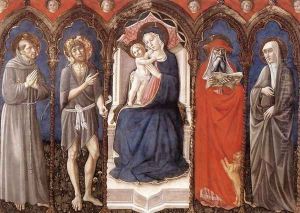Niccolo Da Foligno Paintings
Niccolò di Liberatore, commonly known as Niccolò da Foligno or Niccolò Alunno (his nickname 'Alunno' is a reference to his former status as a pupil), was an Italian painter active during the Early Renaissance period. Born around 1430 in Foligno, a town in the province of Perugia in central Italy, Niccolò became one of the most prominent artists of the Umbrian school. He was notably influenced by the works of his contemporaries, such as Piero della Francesca and Benozzo Gozzoli, as well as by the teachings of the Florentine and Sienese artistic traditions.
Niccolò’s work is characterized by its vivid coloration, devout religious sentiment, and detailed narrative scenes. His paintings often depict biblical and hagiographical stories, filled with emotional expressiveness and a heightened attention to naturalistic details. Over time, he developed a more personal style that incorporated the use of gold leaf and a clear, bright palette, which became distinctive features of his work.
Throughout his career, Niccolò received numerous commissions for altarpieces and frescoes from churches and confraternities across Umbria. Among his notable works are the 'Madonna of Humility' (c. 1470), the polyptych of St. Nicholas (c. 1473), and the 'Annunciation' (c. 1492). His contributions to the art of the Renaissance were significant in the dissemination of the ideas and aesthetics of the period into the Umbrian region.
Niccolò da Foligno's influence extended to his pupils and followers, and his workshop played a key role in the artistic development of Umbria. He passed away in 1502 in Foligno, leaving behind a legacy as one of the most important painters of his time in the Umbrian school. His works continue to be admired for their devotional clarity and their role in bridging the gap between the Gothic and Renaissance styles.
